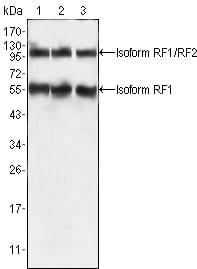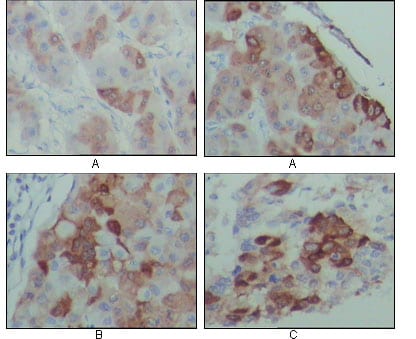


| WB | 咨询技术 | Human,Mouse,Rat |
| IF | 咨询技术 | Human,Mouse,Rat |
| IHC | 1/200 - 1/1000 | Human,Mouse,Rat |
| ICC | 技术咨询 | Human,Mouse,Rat |
| FCM | 咨询技术 | Human,Mouse,Rat |
| Elisa | 1/10000 | Human,Mouse,Rat |
| Aliases | Edr; HB-1; Mar2; MEF3L; Mart2; RGAG3 |
| Entrez GeneID | 23089 |
| clone | 4C10A7 |
| WB Predicted band size | Isoform RF1 (37kDa); RF1/RF2 (80kDa) |
| Host/Isotype | Mouse IgG1 |
| Antibody Type | Primary antibody |
| Storage | Store at 4°C short term. Aliquot and store at -20°C long term. Avoid freeze/thaw cycles. |
| Species Reactivity | Human |
| Immunogen | Purified recombinant fragment of human PEG10 expressed in E. Coli. |
| Formulation | Purified antibody in PBS with 0.05% sodium azide. |
+ +
以下是3篇关于PEG10抗体的参考文献及其摘要概括:
---
1. **文献名称**:*PEG10 as an oncogene: expression regulatory mechanisms and therapeutic implications in hepatocellular carcinoma*
**作者**:Yamaguchi K, et al.
**摘要**:该研究开发了针对PEG10蛋白的单克隆抗体,证实其在肝癌组织中高表达,并证明PEG10通过抑制细胞凋亡促进肿瘤进展。抗体被用于免疫组化检测患者样本中的PEG10表达水平。
---
2. **文献名称**:*PEG10: a novel prognostic marker in prostate cancer via immunohistochemical analysis*
**作者**:Akamatsu S, et al.
**摘要**:研究团队利用特异性PEG10抗体对前列腺癌组织进行染色,发现PEG10高表达与患者生存率降低显著相关,提示其可作为预后标志物及潜在治疗靶点。
---
3. **文献名称**:*Targeting PEG10 with neutralizing antibodies inhibits tumor growth in lung adenocarcinoma models*
**作者**:Li Y, et al.
**摘要**:本研究开发了人源化PEG10中和抗体,体外实验表明其可阻断PEG10介导的Wnt/β-catenin信号通路激活,并在小鼠模型中显著抑制肺癌细胞增殖和转移。
---
以上文献均聚焦于PEG10抗体的开发和应用,涵盖癌症机制研究、诊断标志物探索及靶向治疗验证等领域。如需扩展,可进一步检索PEG10在生殖或神经疾病中的抗体相关研究。
**Background of PEG10 Antibody**
PEG10 (Paternally Expressed Gene 10) is a retrotransposon-derived gene imprinted in mammals, primarily expressed from the paternal allele. It plays critical roles in embryonic development, particularly in placental formation, and has been implicated in oncogenic processes due to its aberrant expression in various cancers. PEG10 promotes cell proliferation, inhibits apoptosis, and enhances metastatic potential by regulating signaling pathways such as Wnt/β-catenin and TGF-β.
PEG10 antibodies are essential tools for detecting and studying PEG10 protein expression, localization, and function in both physiological and pathological contexts. In research, these antibodies are widely used in techniques like Western blotting, immunohistochemistry (IHC), and immunofluorescence (IF) to investigate PEG10's role in cancers, including hepatocellular carcinoma, prostate cancer, and lung adenocarcinoma. Elevated PEG10 levels correlate with poor prognosis, making it a potential diagnostic or prognostic biomarker.
As PEG10 is normally silenced in most adult tissues but reactivated in tumors, targeting PEG10 with therapeutic antibodies or gene-editing approaches is being explored. However, its complex structure and homology to viral proteins pose challenges in antibody development. Ongoing studies aim to clarify PEG10's mechanistic contributions to disease and leverage its cancer-specific expression for targeted therapies.
×